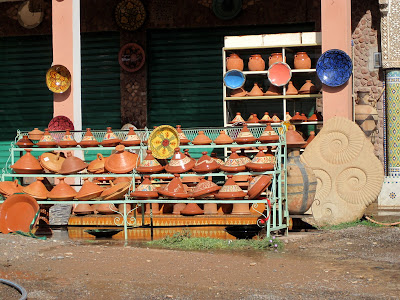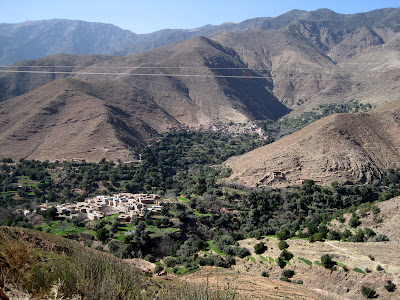We leave Marrakech and drive south into the High-Atlas mountains:
Tagines for sale on the side of the road.
Stopping to see the Ourigane Reservoir.
We are heading to the small town of Tinmel to visit its famous mosque. In the 12th century the Almohads invaded from the south. Tinmel became the capital of the Almohad Empire and the base from which they attacked Marrakech. They conquered Marrakech in 1147 and built the mosque in 1156. Eventually their empire collapsed and Tinmel was destroyed. The mosque was not damaged as it was a holy place but it was abandoned and fell into disrepair.
Now the government is raising money to restore the mosque. It is not being used currently so it is one of two mosques in Morocco that non-Muslims may enter.
The wooden beams of the roof are long gone and the minaret (tower) has also collapsed.
The caretaker explained the history of the mosque in French. Eloïse and Georges translated for everyone else. A lot of Moroccan people, especially in big cities, are bilingual, speaking French and Arabic.
Group 1 had a lovely picnic nearby. Group 2 had ominous clouds and expected rain, so no picnic.
Continuing over the Atlas through the Tizi N'Test pass.
Spectacular geology! This is a beautiful fault... on which the restaurant the second group had lunch at sits on.
Group 2 had lunch at La Belle Vue restaurant.
This was the view!
Well, let's say that the view on a clear day IS amazing, as group 1 saw!
Driving out of the mountains into the valley we stopped at a grove of argan trees. The argan nut is used to make cooking and cosmetic oil and these trees are somewhat famous for being full of goats trying to eat the nuts:
Argan nuts.
We stay the night in Ouad Berehil, in an opulent hotel with lovely citrus groves and peacocks running around:
In the morning we head east to Taliouine to visit a Saffron factory. Taliouine is a relatively wealthy town due to the money from growing the saffron crocus. Saffron spice is the pistil of the crocus. This flower likes very specific hot and arid climates and calcareous soils. One gram of saffron requires 110 flowers!
Here we purchased spice, soaps and other cosmetics made with saffron.
Our next stop is the Angarf South pegmatite. Pegmatites are the source rock for many types of gem crystals, including topaz, tourmaline, and beryl (aquamarine, morganite, emerald). Morocco does not have many pegmatites and this particular one does not have any good gem material. Some colorless beryls were found and mined out years ago. Angarf South is known for rare minerals, including angarfite and melonjosephite (described by Tony). The pegmatite is located in the Zenaga Plains, which are the oldest layer precambrian rocks, collectively called Precambrian 1 (approx. 2 billion years old). Angarf South is part of a granitic complex that intruded into Precambrian 1 approx. 1.8 billion years ago, the rocks are more resistant to erosion and stand out amidst the plains:

We search for rare phosphate minerals like tryphylite but don't have a lot of luck.
Tony and Georges must have been in heaven. They found some blue grunge that might turn out to be a new mineral, stay tuned!
We will spend the next two nights in Tamnougalt, along the river Draa. Tomorrow we visit Bou Azzer!
























No comments:
Post a Comment